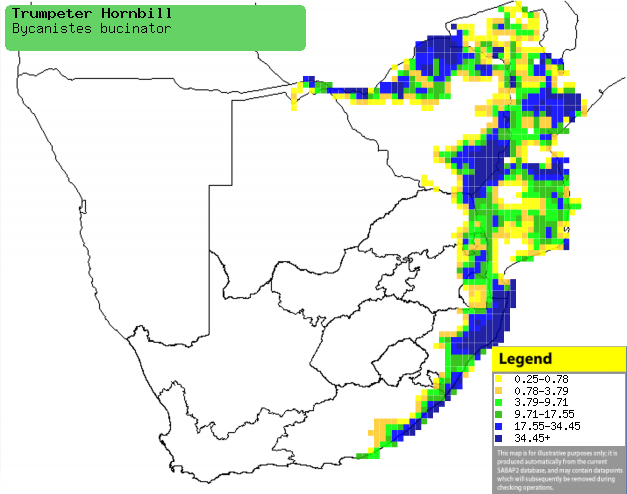|
Bycanistes bucinator (Trumpeter
hornbill)
Gewone boskraai [Afrikaans]; Ilithwa [Xhosa]; iKhunatha
[Zulu]; Gangambudzi [Shona]; Umkhotfo (generic term for hornbill) [Swazi];
Nkorho (generic term for smaller hornbills) [Tsonga]; Kôrwê [Tswana];
Trompetneushoornvogel [Dutch]; Calao trompette [French]; Trompeter-hornvogel
[German]; Calau-trombeteiro [Portuguese]
Life
> Eukaryotes >
Opisthokonta
> Metazoa (animals) >
Bilateria >
Deuterostomia > Chordata >
Craniata > Vertebrata (vertebrates) > Gnathostomata (jawed
vertebrates) > Teleostomi (teleost fish) > Osteichthyes (bony fish) > Class:
Sarcopterygii (lobe-finned
fish) > Stegocephalia (terrestrial
vertebrates) > Tetrapoda
(four-legged vertebrates) > Reptiliomorpha > Amniota >
Reptilia (reptiles) >
Romeriida > Diapsida > Archosauromorpha > Archosauria >
Dinosauria
(dinosaurs) > Saurischia > Theropoda (bipedal predatory dinosaurs) >
Coelurosauria > Maniraptora > Aves
(birds) > Order: Bucerotiformes >
Family: Bucerotidae
The Trumpeter hornbill occurs from Kenya and Angola to
southern Africa, where it is locally common in warm, coastal lowland forest,
especially near watercourses. It mainly eats small fruit, but it does on
occasion hawk insects, especially termite alates and may even eat bird eggs and
nestlings. It normally uses natural holes in trees as nesting sites, which the
female then seals with mud and faeces collected by the male, leaving a small
entrance hole. The female remains in the nest from when the eggs are laid,
through the incubation and nestling periods to when the chicks fledge, a period
of about 94 days!
Distribution and habitat
Occurs from Kenya and Angola to the eastern half of
southern Africa, including Zimbabwe, Caprivi Strip (Namibia), Mozambique and eastern
South Africa. It generally prefers warm coastal lowland forest, often near
watercourses, although often flying across other habitats on its way to new forest
patches.
|
 |
|
Distribution of Trumpeter hornbill in southern Africa,
based on statistical smoothing of the records from first SA Bird Atlas
Project (©
Animal Demography unit, University of
Cape Town; smoothing by Birgit Erni and Francesca Little). Colours range
from dark blue (most common) through to yellow (least common).
See here for the latest distribution
from the SABAP2. |
Food
It mainly eats small fruit supplemented with insects, especially termite alates. It often spends the day in
a single fruiting tree, foraging in it before moving to a different site the
next day. The following food items have been recorded in its diet:
- Plants
- fruit
- Ficus (wild figs)
- Trichilia (mahogonies)
- Ekebergia (ashes)
- Diospyros (jackal-berry)
- Drypetes (ironwoods)
- Rauvolfia caffra (Quinine tree)
- Berchemia (ivories)
- Xanthocercis zambesiaca (Nyala-tree)
- Afzelia quanzensis (Pod-mahogany)
- Rhoicissus (wild grapes)
- Antidesma (tassel-berries)
- Monanthotaxis caffra (Dwaba-berry)
- Pterocarpus (bloodwoods)
- Strychnos (monkey-oranges)
- cultivated fruit
- flowers of Schotia brachpetala (Weeping boer-bean)
- Animals
Breeding
- It normally uses natural holes in trees as nesting
sites. Once a site has been selected the female then seals it with mud and faeces collected by the
male, leaving a small slit. It sometimes uses holes in rock
faces, although not often.
- Egg-laying season is from September-January, peaking from
October-November.
- It lays 2-4 eggs, which are incubated solely by the female for roughly 24
days. The male forages for the female, giving food to her through the
entrance slit.
- The chicks stay in the nest for at least 50 days, remaining near the
nest for about a week before joining the parents in foraging
flights. The female stays in the nest from when the eggs are laid to when
the chicks fledge, a period of about 94 days!
Threats
Not threatened, although vulnerable to forest exploitation.
References
-
Hockey PAR, Dean WRJ and Ryan PG (eds) 2005. Roberts
- Birds of southern Africa, VIIth ed. The Trustees of the John Voelcker
Bird Book Fund, Cape Town.
|
